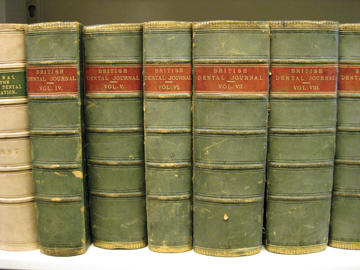ADA Library

ADA Library is a valuable resource
There is an undiscovered gem nestled into the sixth floor of the American Dental Association building on Chicago Avenue. It offers many resources in one place that can’t be found anywhere else – that is, anywhere else that is easily accessible. It offers seemingly boundless knowledge about any subject; some the information dating back to the 1800s.The ADA library, a resource unknown to many members, has been open since 1927 with the goal of giving dentists the ability to go to one place to find resources that might help them in their practice. Today, it maintains the goal; except that with the invention of multiple technologies since 1927, there is now a wider breath of available resources – even international ones.
“[The dentist] has such a wide range of resources available that are easily accessible,” said Ruth Schultz, manager of public services at the library. “We are even available to help search for more specific information.”
With an estimated 35,000 books, volumes and journals in the library, ADA members are bound to find what they are looking for when they visit. There are about 650 journals kept on file. While many dentists receive the standard journals in the mail akin to their specialty like the Journal of the American Orthodontic Society, what they might not receive are international journals written in English, like the Scandinavian Journal of Dental Research. When looking at other journals rather than just the normal ones there is an opportunity to be introduced to a wider range of research and broader horizons.
Many dentists call or visit the library with patient-based questions about how to handle a certain treatment situation in the office. A patient might be taking a particular medication and the doctor is wondering if a specific anesthetic might have a counter effect.
Or doctors call with questions regarding practice management and hiring practices.
If a member has a presentation coming up and needs help with research, he or she can request the journal articles they need for a fee; each article can be sent electronically or by mail. If a member is unsure of what article they want but knows the subject or topic, the library is willing to do the research and send five to eight articles, also for a fee.
The library staff also provides free tours of their facility and introduces guests to everything that they have to offer. There is even a display case of artifacts from the history of dentistry. Whether it is old dental tools, toothpaste in a tin, or dentures from the early 20th century, it is there for your viewing. And if a patron is looking for a book published before 1980, they could even try looking in the old card catalogue for kicks.
There are plenty of books available for members to checkout ranging in a multitude of dental subjects. However, on one wall the library stocks books written by dentists on subjects other than dentistry and even children’s books discussing oral health, suitable for classroom presentations to younger children. There is also the ADA’s list, updated quarterly, of new books introduced in the dental field; they too are available for checkout. Members can send staff to checkout books for them; all they need to have with them is the dentist’s ADA number.
Whether a member lives in Chicago or far away, the library can be accessed many different ways. Call on the phone with questions. Visit the Web site and log in as a member. Or just stop in and visit. Whichever way you choose to use the ADA’s multiple tools and resources, the library staff is willing to reach out and help anyway they can.
